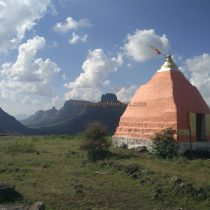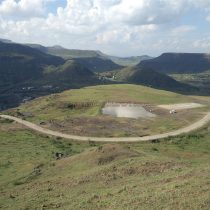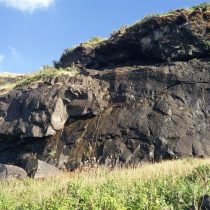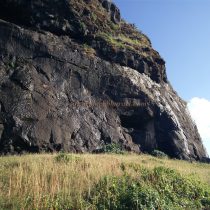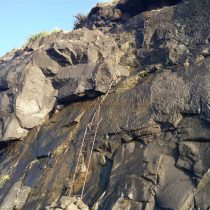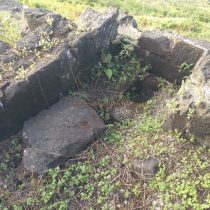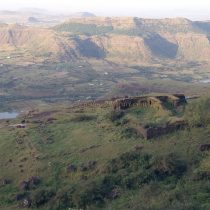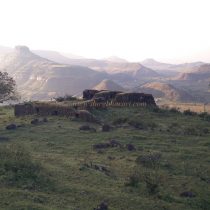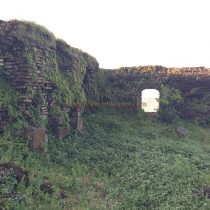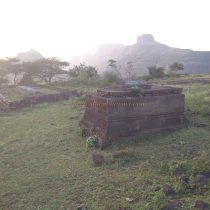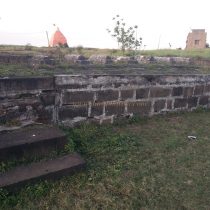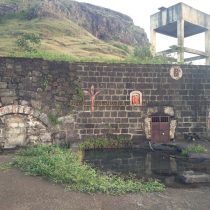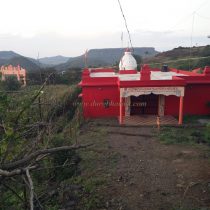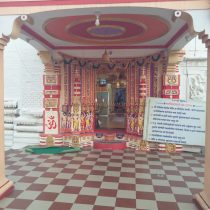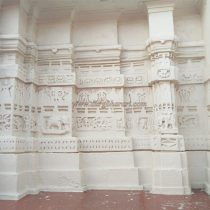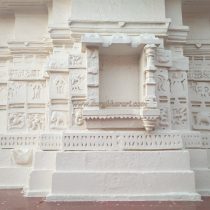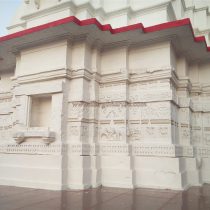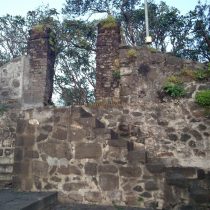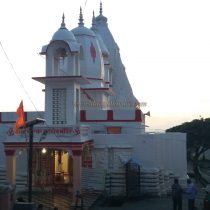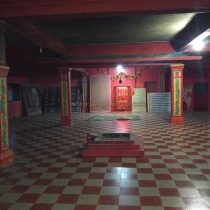CHANDWAD
TYPE : HILL FORT
DISTRICT : NASHIK
HEIGHT : 3955 FEET
GRADE : VERY HARD
While wandering around the fort, interacting with the locals, you can get some clues about the time of construction of the fort. If the villagers say that the fort was built by Shivaji Maharaj, then the fort is considered to be medieval. If they say that the fort was built by Pandavas, then the fort is ancient. Chandor aka Chandwad fort is one such ancient fort in Chandwad taluka in the Satmal mountain range of Nashik district which is associated with Agastya sage. This fort is at a distance of 60 km from Nashik on the Mumbai-Agra highway. The city of Chandwad is adjacent to the highway and Chandwad fort is on the hill behind the city to protect it. The city of Chandwad is well connected by road to many cities and has good transport facilities.
...
Lasalgaon and Manmad are the nearest railway stations to the fort at a distance of 19 km and 25 km respectively On the way from Nashik, 6 km on the highway in front of Chandwad Pathkar Naka. At the top right is the road leading to Chandreshwar temple. The fort is divided into two parts, Plateau and citadel. Since the forest department has made a road to Chandreshwar temple on the plateau, if you have a private vehicle, you can go to Chandreshwar temple premises by car. As the hill of the fort is spread from east to west and the plateau is a part of the fort, you should start your journey from the plateau itself. Built-in the 8th century, this ancient temple has been renovated by Ahilyabai Holkar and has now been rebuilt in some places. Seeing this confluence of old and new construction, you should walk around the temple. Some broken carved idols are lying in the temple premises as well as beautiful pillars of the temple. There are many sculptures carved on the exterior of the temple and in some places Surasundari is carved. Devkoshtake of the temple is empty. The entire temple is painted white and the facade area is colorfully painted. While walking around the temple, one can see a broken Shivling and Nandi as well as two broken idols. After visiting the temple of Chandreshwar, one should come out of the temple by the steps in front of the temple door. On the right side of the road, there is a cistern carved in the rock, and on the left side of the road is a newly built Maruti temple but the idol in this temple is from the Peshwa period. When we come to the front, there is a wall built in wrought stone in recent times and this wall has three Ganesha sculptures and one of them is broken hero stones. There is a small iron door in this wall and on the inside of the door there is a cave carved in the rock and there are water cisterns in this cave. Gomukh is installed at the bottom of the wall and water flows in a small cistern under it till about December. On the way from here, there is a manmade circular pond built on the way. On the left side of this lake, there are two tombs and some remains of buildings. Next to the memorial, there are seven tombs built on a quadrangle structure, and in front of this tomb, there is another big memorial. From here you can see a domed temple in front. There is an idol of Ganesha in this temple. There is a wire fence at the top of the hill. Here, on the left side, at the top of the lake, as soon as the wire fence ends, a bold footpath leads to the fort, climbing a little ahead on this path, you see a path on the left which leads to a mint, while the path on the right takes you to the bastion below the fort head. On the left side path towards the mint, there are scattered remnants of small structures, and next to it, on the slope, there is a large quadrangle structure built of crushed stone. After seeing this structure and going uphill to the left, in 15-20 minutes we reach the ruined building of the mint. The door and walls of the building are still standing today and in some places, there are mud pipes in the wall. Someone with the knowledge of the fort & mint should accompany you to explain its structure. After seeing the mint, start climbing on the west side of the fort. This path is in bad condition and the steps are carved in some places. This way we reach the top of the fort. This place was formerly fortified, but today only its remains exist. In this rampart, you can see a toilet and two bastions. There are 10-12 caves carved in the belly of the hill and all these caves are covered with stones and bushes. There are a large number of stones scattered here and all these stones are of the steps broken by the British. The footpath leading to the fort has been destroyed and an iron ladder has been installed here. There is a Persian inscription carved in the rock on the right side of the ladder which states that this fort and other forts were conquered in 1636 by Alivardi Khan, a servant of Shah Jahan. On the right side of the inscription, a cave is carved and there are also two other caves carved under it. As the ladder is very steep and incomplete, you require mountaineering equipment and ropes to climb this particular stage. We had gone to the fort with all our supplies, but the stage was very mossy and slippery due to two days of unseasonal rains. Guide Vasant Jadhav aka Vasantmama, who easily crossed this stage, slipped twice at this stage, so we completed our journey here without taking any further risk. One and a half hours is enough to reach from Chandreshwar temple to the ladder. From this part of the gate, Indrai fort, the hill of three and a half roads, and the range of Satmala hill can be seen. Keeping in view the expenditure incurred in the Chandreshwar temple area in the name of tourism development, a ladder could have been installed to reach the fort at a very meager cost, but according to the tourism department, the cost of the fort should be zero. Next time when we visit this fort, we will go to the top. Let's turn to the history of the fort. According to a legend, when the sage Agastya was in Chandwad, he was cursed by the people of Chandwad for not giving him ghee. In the book Shanimahatma, Chandwad is called Tamralindapur, while in Jain literature, Chandwad is referred to as Chandradivyapuri. No one knows who built the Chandwad fort and when, but the copper plate of the Chalukya king Chandraditya aka Nagvardhan (650 AD) found at Nandgaon mentions Chandradityapur i.e. Chandwad. It mentions that the founder of the Yadav dynasty, Drudhaprahar, settled at Chandradityapur in the 8th century AD. Chandwad fort is believed to have been built during the reign of this strong king. After this, Seunchandra, the son of Drudhaprahar, established his capital at Sinnar, the area was ruled by the Bahamani in the 14th century, but after the Bahamani rule, the province became part of Nizamshah. In 1635, the Mughal emperor Shah Jahan sent Shahistekhan to Maharashtra. Inscriptions mention that many forts were conquered in the area including Chandwad during 1636. Chandwad was renamed Jafrabad during the Mughal period. In 1667, Bakikhan was the fort keeper of Chandwad. It is mentioned that during 1667-1670, Maharaj plundered the city of Chandwad and took 1 elephant, 12 horses, and Rs. 40,000. At this time, the fort keeper Baki Khan hid in the fort, while Lodi Khan, the faujdar of Talkokan was defeated. Maharaj plundered Surat for the second time in September 1670, on his way back from Baglan, Dawood Khan Qureshi, the Subhedar of Khandesh, reached Chandwad fort on October 16, 1670, with 5,000 troops to capture the treasure from Maharaj and prepared for the battle of Kanchanabari. It is mentioned that in October 1682, during the reign of Chhatrapati Sambhaji Maharaj, a detachment of Marathas marched on Chandwad. Abdullah, the Thanedar of Chandwad, and the fort keeper were unable to stop the detachment. It is mentioned that Rahimuddin, Raghunath Singh, and Mahipat Singh were Mughal fort keepers later during this period. In 1724, when Asafjaha Nizam Ulmuk declared his independent kingdom in the south, this part came under his control but soon Chandwad fort came under the control of Marathas during the first Bajirao period. Later Nanasaheb Peshwa gave Chandwad Jahagiri to Malharrao Holkar and the fort of Chandwad came under control of him. During this time copper business flourished here. The Chandreshwar temple was renovated by Ahilyabai Holkar in 1740. The temple on the red hill under the Chandreshwar temple was also renovated during this period. Santaji Mohite was the fort keeper here from 1749-50. In 1772, with the permission of Madhavrao Peshwa, Tukoji Holkar started a mint of Chandori rupees on Chandwad fort. This Chandwadi rupee is known as Chandwadi Turra. Uddhav Vireshwar was the fort keeper here during 1773-74. During this period, Chandwad fort was used as a prison and the accused in the murder of Narayanrao Peshwa were imprisoned here. In 1800, due to a quarrel between the fort keeper and mint officer, the mint was shifted to Chandwad village. In the same year, Ahmed Khan and Amir Khan of Yashwantrao Holkar's army looted Malegaon and Chandwad. In 1804, Colonel Wallace captured Chandwad and handed it over to Holkar again. In April 1818, Thomas Hislop recaptured Chandwad from Holkar. Recognizing the importance of Chandwad Ghat for transportation, Lieutenant Colonel McDowell and his army camped at Chandwad. In 1829, the work of minting silver rupee coins in Chandwad Mint was stopped. In 1830, the minting of copper coins was stopped and the mint was closed. After the uprising of 1857, the British destroyed the footpath leading to the fort.
© Suresh Nimbalkar

